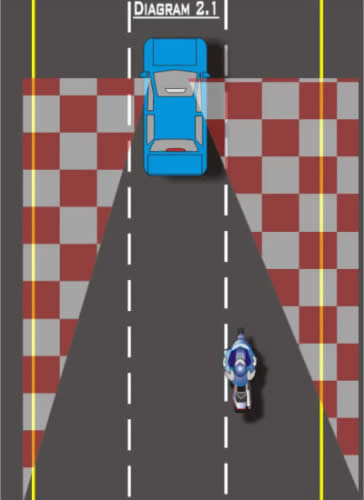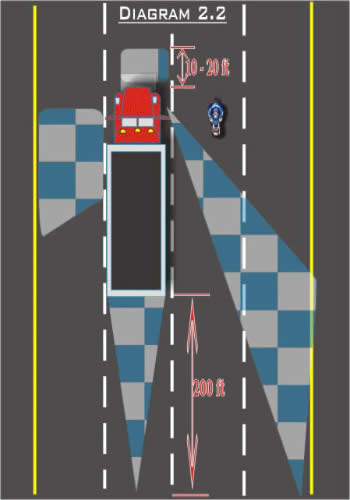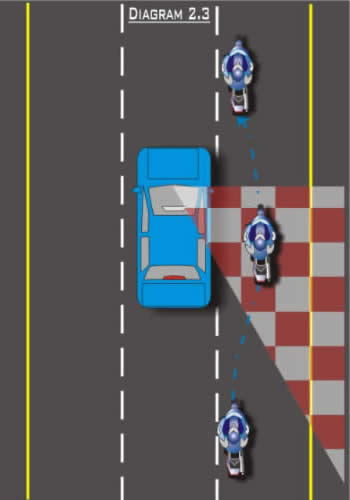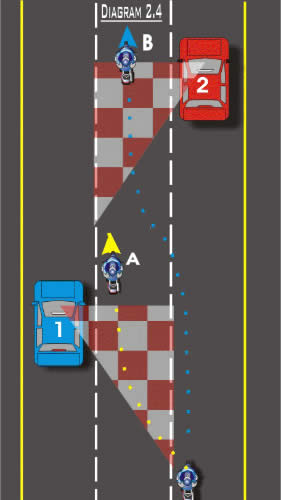Motorcycle blind spot
One of the most dangerous situations that a motorcyclist can find him/ herself in is in a lane that is about to be taken over by a Car, SUV, or Truck. Many riders spend a lot of time in a vehicle’s blind spot not realizing the dangers that they are in, (the area that is not covered by the mirrors on a car or truck). In order to see this area a driver must turn his/ her head to check what is in their blind spot. Unfortunately a lot of drivers out there don't bother to check their blind spots (they only use their mirrors) before making a turn or lane change. And as a motorcycle rider you don't want to be in that space when the driver of a much heaver vehicle wants to be there as well.

Diagram 2.1 indicates where the blind spots are located on a car. This is the place where a rider should not spend a lot of time. The easiest way to tell if you are in a vehicle’s blind spot is to look into the car/ truck mirrors, if you cannot see the driver’s face... Guess what? You are in his or her blind spot. This means that you are invisible to the driver, unless they turn their head and check their blind spot before making a move.

Diagram 2.2 shows where the blind spots are located on a large truck. Note that the blind spots on a truck are much larger than that of a car, especially the spot located directly behind the trailer. This area extends approximately 200 feet. You can imagine how easy it would be for something as small as a motorcycle to get lost back there. The best thing for a rider to do is to keep his/ her distance when riding behind a truck. Also if a rider is following too closely behind a truck, how far ahead in traffic can he/ she see? The answer is obviously not very far!

Now I know what you are thinking, when you are riding in heavy traffic it is impossible not to be in someone’s blind spot. So then what can you do? When riding beside another vehicle, a rider should position him/ herself either slightly ahead or far enough behind so that he/ she can easily be seen by that driver. Diagram 2.3 demonstrates how a rider can pass through another vehicles blind spot. As the rider begins to pass the car on the left, he/ she also moves over to the right side of the lane, creating a space cushion incase the driver decides to change lanes. After passing, the rider then returns to left side of the lane (his/ her blocking position).

A common mistake that some riders make is that they unintentionally change lanes into another vehicle’s Blind Spot. In Diagram 2.4 we see that if the rider takes path (A) he/she rides directly into Car # 1's Blind Spot. If that driver decides to change lanes then the rider might be in big trouble. Notice however, that by taking path (B) the rider stays out of car #1’s Blind Spot altogether. Also as the rider approaches car # 2 he/ she stays in that drivers mirrors as long as possible. When it comes time to pass that car the rider moves over to the left side of the lane, creating a safety cushion.
As I have stated before it is almost impossible not be in someone’s Blind Spot when you are riding on a busy road or highway. The key is not to spend a lot of time there. And when you have to pass through a blind spot do so as quickly and safely as possible.





